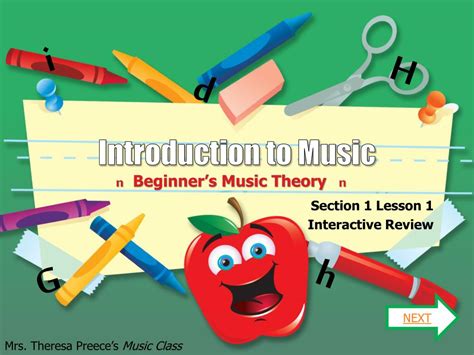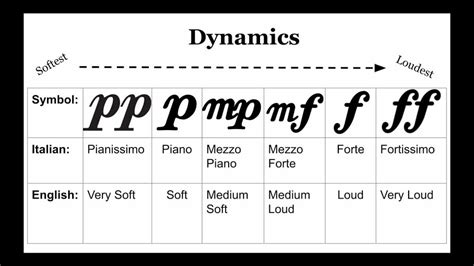Music dynamics refer to the varying degrees of loudness and softness in music, which play a crucial role in conveying emotion, creating contrast, and adding depth to a musical composition. The term “dynamics” comes from the Greek word “dynamis,” meaning power or force, and in music, it refers to the way a musician or ensemble controls the volume of sound to create a specific effect.
In music notation, dynamics are indicated by a set of Italian words and symbols, which provide a standardized way of communicating the desired level of loudness or softness to the performer. The most common dynamic markings include:
- Piano (p): soft or quiet
- Pianissimo (pp): very soft or very quiet
- Mezzo-piano (mp): moderately soft
- Mezzo-forte (mf): moderately loud
- Forte (f): loud
- Fortissimo (ff): very loud
- Crescendo (cres): gradually getting louder
- Decrescendo (decres): gradually getting softer
These dynamic markings can be used in various ways to create different effects, such as:
- Contrast: sudden changes in dynamics can create a sense of contrast, adding drama and interest to a musical piece
- Expression: dynamics can be used to convey emotion and expression, with softer passages often used to convey intimacy or vulnerability, and louder passages used to convey excitement or energy
- Phrasing: dynamics can be used to shape the phrase structure of a musical piece, with softer passages often used to separate phrases or create a sense of finality
Types of Dynamics

There are several types of dynamics, each with its own unique characteristics and uses:
- Articulatory dynamics: refer to the way notes are attacked and released, with different articulations (such as legato or staccato) affecting the overall dynamic of a passage
- Timbral dynamics: refer to the way the tone color or timbre of a sound changes over time, with different instruments or voices producing unique timbral dynamics
- Rhythmic dynamics: refer to the way rhythmic patterns and accents affect the overall dynamic of a passage, with syncopation and accentuation adding complexity and interest
Historical Development of Dynamics
The use of dynamics in music has evolved over time, with different historical periods and styles emphasizing different aspects of dynamic control. For example:
- Baroque period: dynamics were often used to create dramatic contrasts, with sudden changes in volume and intensity used to convey emotion and drama
- Classical period: dynamics were often used to create a sense of balance and proportion, with gradual changes in volume and intensity used to shape the phrase structure of a musical piece
- Romantic period: dynamics were often used to create a sense of expressiveness and emotion, with extreme contrasts in volume and intensity used to convey intense emotions and dramatic contrasts
| Historical Period | Dynamic Characteristics |
|---|---|
| Baroque | Sudden contrasts, dramatic changes in volume and intensity |
| Classical | Gradual changes, balance and proportion |
| Romantic | Extreme contrasts, expressiveness and emotion |

Practical Applications of Dynamics

Dynamics play a crucial role in a wide range of musical genres and styles, from classical music to jazz and pop. Some practical applications of dynamics include:
- Orchestration: the use of different instruments and instrumental combinations to create a wide range of dynamic contrasts and textures
- Vocal technique: the use of different vocal techniques, such as breath control and phrasing, to create dynamic contrasts and expressive effects
- Recording and production: the use of recording techniques, such as compression and limiting, to control the dynamic range of a recorded sound
Key Points
- Dynamics refer to the varying degrees of loudness and softness in music
- Dynamic markings, such as piano and forte, are used to indicate the desired level of loudness or softness
- Dynamics can be used to create contrast, convey emotion, and add depth to a musical composition
- There are several types of dynamics, including articulatory, timbral, and rhythmic dynamics
- Understanding the historical development of dynamics can inform your approach to dynamic control and provide a deeper appreciation for the expressive possibilities of music
Common Challenges in Working with Dynamics
Working with dynamics can be challenging, particularly for musicians and composers who are new to the concept. Some common challenges include:
- Balancing contrast and unity: creating a sense of contrast and variety, while also maintaining a sense of unity and coherence
- Controlling dynamic range: managing the dynamic range of a musical piece, to create a sense of drama and contrast without overwhelming the listener
- Developing expressive technique: developing the technical skills and expressive abilities necessary to convey emotion and expression through dynamics
By understanding the principles of dynamics, and practicing expressive technique, musicians and composers can create music that is engaging, expressive, and emotionally resonant.
What is the difference between piano and pianissimo?
+Piano (p) indicates a soft or quiet dynamic, while pianissimo (pp) indicates a very soft or very quiet dynamic. The main difference between the two is the degree of softness, with pianissimo being significantly softer than piano.
How do I create contrast in a musical piece using dynamics?
+Contrast can be created in a musical piece using dynamics by sudden changes in volume and intensity, or by gradual changes in volume and intensity over time. For example, a sudden shift from a soft passage to a loud passage can create a sense of drama and contrast.
What is the role of dynamics in conveying emotion in music?
+Dynamics play a crucial role in conveying emotion in music, as they can be used to create a sense of intimacy, vulnerability, or excitement. Soft passages can create a sense of intimacy and vulnerability, while loud passages can create a sense of energy and excitement.
Meta Description: Learn about music dynamics, including the different types of dynamics, historical development, and practical applications. Understand how to create contrast, convey emotion, and add depth to a musical composition using dynamics. (149 characters)



